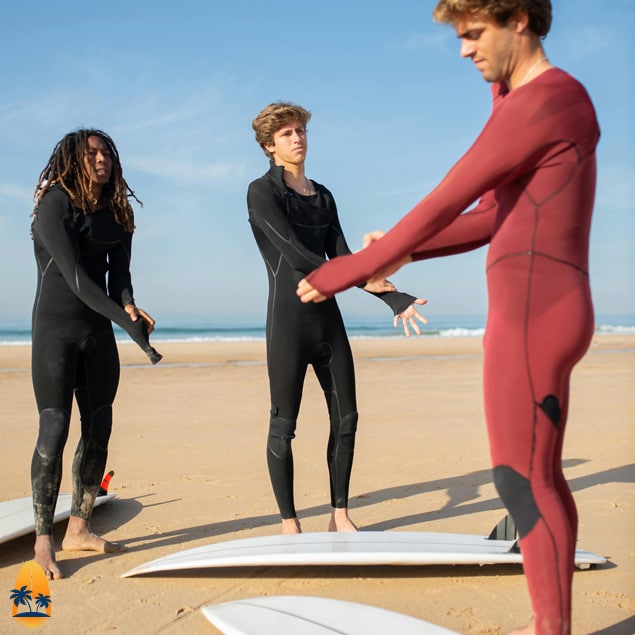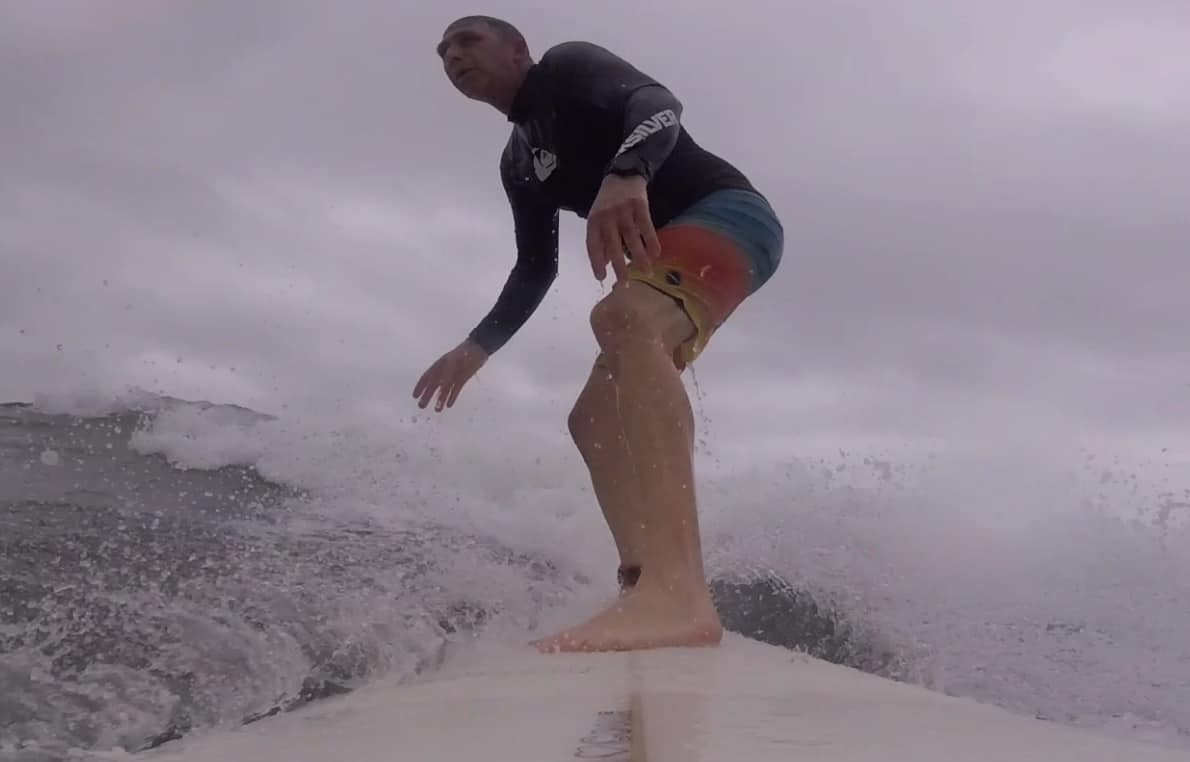Knowing what wetsuit to wear based on the water temperature is key to staying warm and comfortable while surfing. Wetsuits come in different thicknesses to handle different temperatures. Choosing the right one can make a big difference in how much fun you have in the water. This simple surfing wetsuit temperature guide breaks down wetsuit thicknesses for different water temperatures
Wetsuit Thickness and Temperature Chart
| Water Temp | Wetsuit Thickness | Wetsuit | Extras |
|---|---|---|---|
| Above 75°F / 24°C | None | Rashguard and Board shorts | Consider a thick rashguard in heavy wind or at dawn and dusk |
| 70°F – 75°F 21°C – 24°C | 1mm or 2mm | Shorty or Spring Suit | Consider long sleeves in heavy wind or at dawn and dusk |
| 65°F – 70°F 18°C – 21°C | 2mm – 3mm | Shorty of Full Wetsuit | Consider a full suit in heavy wind or at dawn and dusk |
| 60°F – 65°F 16°C – 18°C | 3/2mm | Full Wetsuit | Consider a 4/3mm full suit for dawn and dusk |
| 50°F – 60°F 10°C – 16°C | 4/3mm | Full Wetsuit | Booties are a good idea. Gloves are optional. |
| 45°F – 50°F 7°C – 10°C | 5/4mm or 5/4/3mm | Full Wetsuit | Wear booties and gloves. Wearing a hood is also a good idea |
| Below 45°F (7°C) | 6/5mm – 7mm | Full Wetsuit | If you’re not planning on wearing a hood, booties, and gloves you’re probably crazy |
What Does 3/2mm or 4/3mm Mean for Surfing Wetsuits?
When you see wetsuit thicknesses listed as numbers, like “3/2” or “4/3,” it refers to the thickness of the neoprene in different parts of the wetsuit. The first number is the thickness (in millimeters) of the neoprene around your torso. The second number is the thickness around your arms and legs.
For example:
- 3/2mm Wetsuit: The torso has 3mm neoprene, and the arms and legs have 2mm. This combination keeps your core warmer while giving your arms and legs more flexibility. A 3/2 is popular for moderate water temperatures, like 60°F to 70°F (16°C to 21°C).
- 4/3mm Wetsuit: The torso has 4mm neoprene, and the arms and legs have 3mm. This provides extra warmth for colder waters, around 50°F to 60°F (10°C to 16°C), while still allowing some flexibility in your arms and legs.
The idea is to keep your core—the area that helps regulate body temperature—as warm as possible. At the same time allowing you to move your limbs more freely with slightly thinner neoprene. The thicker the neoprene, the warmer the wetsuit will be, but it also becomes less flexible and can make paddling a bit harder.
Surfing Wetsuit Temperature Guide FAQs
Why do I need a wetsuit in cold water?
Wetsuits trap a thin layer of water between your body and the suit. Your body heats this water up, keeping you warmer in chilly conditions. Without a wetsuit, you lose heat faster, which can make surfing uncomfortable and even dangerous in cold water.
Can I wear a thicker wetsuit in warmer water?
You can, but it might be uncomfortable. Thicker wetsuits are harder to paddle in and can make you overheat in warm water. It’s best to match your wetsuit thickness to the water temperature to avoid feeling too hot or too restricted.
Do I need booties, gloves, and a hood?
When water temperatures dip below 60°F (16°C), it’s often a good idea to wear booties. For water below 50°F (10°C), gloves and a hood become necessary to keep your extremities warm and prevent loss of body heat.
How long does a surf wetsuit last?
With proper care, a wetsuit can last several years, but it depends on how often you use it and how well you take care of it. Rinsing it with fresh water after each session, drying it in the shade, and storing it correctly can all extend its lifespan.
What happens if I don’t wear a wetsuit in cold water?
In cold water, your body loses heat quickly, which can lead to hypothermia. Even if you don’t feel super cold right away, you may tire out faster, lose coordination, and face serious risks if you stay in the water too long without proper insulation.
How to Choose a Wetsuit for Surfing
- Check the Water and Air Temperature: Water temperature can vary a lot depending on the season and location. Use a reliable source or local surf report to find the current water temperature.
- Consider Your Cold Tolerance: Some surfers feel colder than others, so you might need a thicker wetsuit if you tend to get chilly easily.
- Look for Wetsuit Seals and Zippers: Higher-quality wetsuits have sealed seams that keep water out better. Different zipper styles (like chest zips) also help block cold water from entering.
I prefer chest zip wetsuits even though getting out of them is a little more challenging for me. Overall I think they are warmer than back zip wetsuits. - Remember to Size Your Wetsuit Correctly: A wetsuit should be snug but not too tight. If it’s too loose, it won’t insulate as well because more cold water will get inside.
Top Wetsuit Companies For Surfing
O’Neill
- About: O’Neill is one of the oldest surf brands and was founded in California in the 1950s. It’s known for creating the first neoprene wetsuit, which helped keep surfers warm in cold water.
- Known for: Their Hyperfreak and Psycho Tech wetsuits are very popular. These suits are lightweight, stretchy, and have excellent insulation to keep you warm.
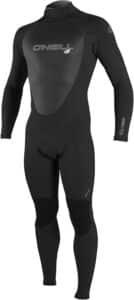
Check out O’Neill.com or O’neill at Amazon
Rip Curl
- About: Rip Curl is an Australian company known worldwide for surf gear. They’re big on innovation and make high-quality wetsuits for all conditions.
- Known for: The Dawn Patrol wetsuit is well-loved by surfers for its balance of performance and price. Their Flashbomb series is also popular for its quick-drying material.
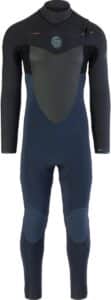
Check out RipCurl.com or Rip Curl at Amazon
Billabong
- About: Another Australian brand, Billabong is known for stylish and reliable surf gear. They offer wetsuits for all ages and water conditions.
- Known for: The Furnace wetsuit series is a top pick, with lots of insulation and comfort. Their Absolute wetsuits are also known for quality at a good price.
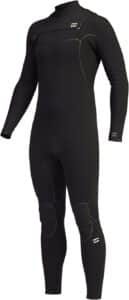
Check out Billabong.com or Billabong at Amazon
Quiksilver
- About: Quiksilver is a famous surf brand from Australia, known for both performance and style. Their wetsuits are durable and work well in different temperatures.
- Known for: The Highline Pro series is a favorite for its stretchiness and comfort. The Everyday Sessions wetsuits are also popular for surfers looking for good value.
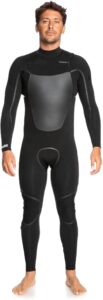
Check out Quicksilver.com or Quicksilver at Amazon
Xcel
- About: Xcel is a brand based in Hawaii, known for making wetsuits that can handle very cold waters. They focus a lot on warmth and flexibility.
- Known for: The Drylock series is one of their best, designed to keep water out and keep surfers warm. The Comp X wetsuit is also well-known for its flexibility and comfort.
Check out Excel Wetsuits Here
Patagonia
- About: Patagonia is all about environmentally friendly products. Their wetsuits are made with natural materials, which makes them unique.
- Known for: Their R1 Yulex and R3 Yulex wetsuits are eco-friendly and great for different water temperatures. Yulex is a natural rubber alternative, and Patagonia uses it instead of traditional neoprene.
Check out Patagonia Wetsuits Here
Hurley
- About: Hurley is a California brand known for its surf gear. They design wetsuits that are comfortable and affordable, making them a good choice for newer surfers.
- Known for: The Advantage Plus wetsuit is a popular pick for its flexibility and fit. Hurley’s Fusion series is also affordable and comfortable for beginners.
Check out Hurley.com or Hurley at Amazon
Vissla
- About: Vissla is a newer surf brand, but they’re gaining attention for their focus on style and sustainability. They make eco-friendly wetsuits with recycled materials.
- Known for: The 7 Seas wetsuit line is known for its good value, flexibility, and warmth. It’s also made from eco-friendly materials, which many surfers like.
Check out Vissla Wetsuits Here
To close out this post on our surfing wetsuit temperature guide
With the right surf wetsuit for the water temperature, you’ll be comfortable, stay out longer, and enjoy your surfing sessions more. Remember to check the water and air temperature before you go and choose a wetsuit that fits well. The above companies are known for quality and will help you maximize getting the most out of this surfing wetsuit temperature guide!

